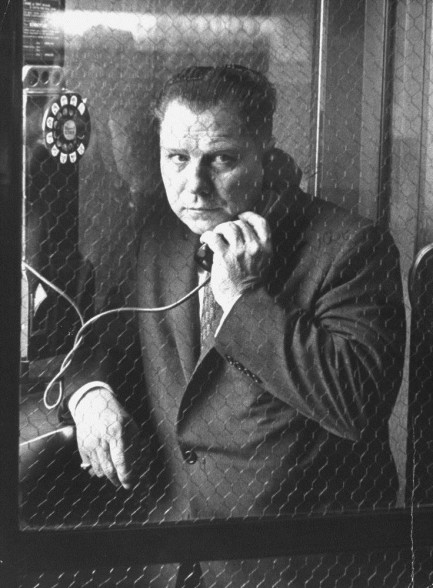 T-Men shows Uncle Sam's money men hard at work keeping the greenback safe. 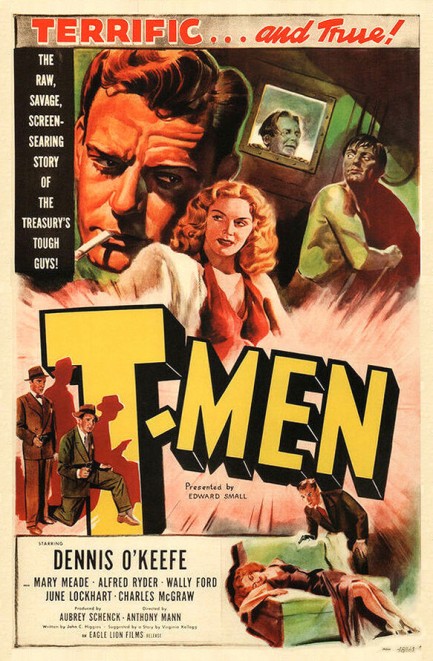
As you know by now, film noir derived from several sources, one of them being the hard-boiled pulp fiction of the 1930s and ’40s, such as the aforementioned Kiss Me, Deadly. As the cycle rolled onward, filmmakers routinely mined crime fiction for movies, and it became common for a book to be purchased for adaptation immediately after it was published. It was a heyday for crime authors. T-Men, for which you see a cool poster above and another at bottom, was not adapted from a novel. It came from a story idea by Virginia Kellogg, the unheralded brain behind films such as White Heat and Caged.
T-Men is the narrated tale of two treasury agents who infiltrate the Detroit mafia to stem a wave of counterfeiting. Dennis O'Keefe and Alfred Ryder play the duo of undercovers, looking sharp in their tailored suits, as they climb the mob chain of authority pretending to be in the possession of flawless counterfeiting plates they're willing to sell. The two take numerous risks to get close to the unknown head of the mob, and find themselves in hot water more than once. The question quickly becomes whether they can catch the crooks and stay alive.
You get excellent noir iconography here, courtesy of director Anthony Mann and cinematographer John Alton. In fact, though the movie is good anyway, the main reason to watch it is because it's a clinic in genre visuals, filled with beautiful shots where light and darkness intersect in sharp angles or blend like mist. The movie also makes good use of locations tailor-made for shadowplay—the steam room, the deserted street, the nighttime amusement park, the swank supper club, the gambling den, the photographer's darkroom, the industrial maze. If you didn't know better you'd think the filmmakers chose the locations first, then built a movie around them.
For those reasons, T-Men is a mandatory entry for film noir buffs, however it isn't quite perfect. Though there are many surprises, aspects of it related to survivability are predictable, and the narration nestles right up against pro-government propaganda, particularly toward the end. Generally, we think most vintage films could have done fine without narration, but here it's actually needed, so you'll have to ignore the filmmakers intent to teach the audience a lesson. That shouldn't be too hard—T-Men is an almost perfect noirscape, a place to get lost in darkness and enjoy the ride. It premiered in the U.S. today in 1947.
 So many choices, so little time. 
We found this interesting photo on Reddit. It shows an actual pulp rack at the Detroit Metro Airport in 1959. It's amazingly full. We had no idea the racks offered this level of choice. Jonathan Latimer once famously described his books as being about, “booze, babes and bullets,” and the choices shown here certainly reflect the simple enticements of popular mid-century fiction. We were surprised and pleased to find that we own three of those shown. Carter Brown's The Dame and None but the Lethal Heart, and Edmond Hamilton's The Star of Life, are currently in our holdings. Seeing them on an actual spinning rack circa late-1950s is cool. It gives them new life for us.
Speaking of new, the international mails have been working flawlessly of late, and we've received some very choice items, including a stack of digest novels from Uni, Rainbow, and similar imprints, and some Dell and Signet crime paperbacks. We've already begun posting some of this stuff, for example The Nude Stranger and Dirt Farm. We also got our hands on the novelization of the blaxploitation film Coffy. Look forward to that. And on top of everything else, we also bought some fun French nudie mags, and a fresh lot of periodicals from Australia, including more issues of Adam, Man, and Man Jr. We'll get to scanning and you can expect those to start popping up pretty soon. 
 There's never a RoboCop when you need one. 
The city of Detroit recently rejected a statue of the main character from 1987's RoboCop, made by a local artist group and meant to be displayed at the city's Michigan Science Center. Seizing the opportunity, the mayor of Stevens Point, Wisconsin—which is where RoboCop star Peter Weller was born—has offered a place for the statue in the town of 26,000. Mayor Mike Wiza called the artists, as well as Peter Weller's family. in a so-far unsuccessful attempt to secure the figure. The story amused us because, though on the surface the statue seems like a fitting public monument for Weller's hometown, we wonder if Mayor Wiza knows that RoboCop, aside from being a very good movie, is director Paul Verhoeven's dark satire of the U.S.
The movie hits on several areas, including policing and television culture, but most particularly it's a cautionary epic about the power of corporations. It made the prediction, also made by others, that all life would soon be controlled by corporations, and by extension the unelected, megarich heads of those entities. Those who doubt 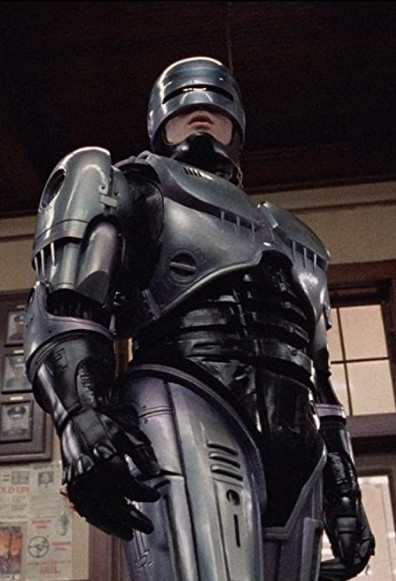 we've reached this point should read up on private prisons, or Citizen's United v. FEC, or Facebook's recent attempt to punish the entire country of Australia by slapping it with a news ban. we've reached this point should read up on private prisons, or Citizen's United v. FEC, or Facebook's recent attempt to punish the entire country of Australia by slapping it with a news ban.
RoboCop goes on to posit that corporations allowed to grow and spread unchecked inevitably make the business decision to place profit above human lives. It didn't mean lives in some distant corner of the globe, or some urban niche of Detroit, where the movie was set. That was already clear. The movie's incisive subtext was that the lives of middle Americans—the very people who live in Stevens Point—would soon be deemed expendable too.
When movies like this pop up they create a paradox: people generally won't watch social critique films unless they're violent and/or funny, but when they're violent and/or funny the majority of people don't get the critiques, even when those are obvious. Examples: Starship Troopers (also a Verhoeven film), Being There (which starred Dr. Strangelove's Peter Sellers), 2019's Us (whose unspoken but glaringly obvious alternative title is, “U.S.”), and, to cite a particularly clear-cut example of blunt satire, They Live, which a substantial minority of filmgoers still managed to think of as merely a strange and slow-moving sci-fi invasion flick.
It's possible Mayor Wiza knows exactly what RoboCop is about, but simply can't pass up the chance to plant something in the town square that will bring gawkers and Instagramers to local restaurants and add warm bodies to the yearly artwalk. If he succeeds, in public he'll hail his coup as an economic victory for his administration (though mainly for the town, always the town first). But later he'll stand at a window in city hall, looking down at RoboCop, nodding thoughtfully as he explains to some nearby aide, “The ironic part of turning that statue into a public monument is that RoboCop, aside from being a very good movie, is director Paul Verhoeven's dark satire of the U.S.” 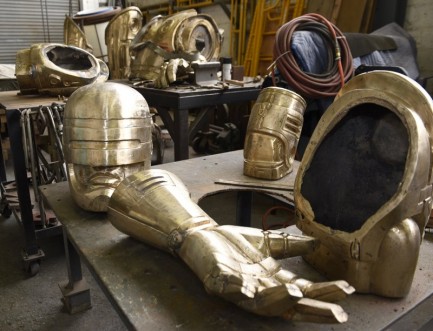
 Even Hollywood trailblazers get the blues. 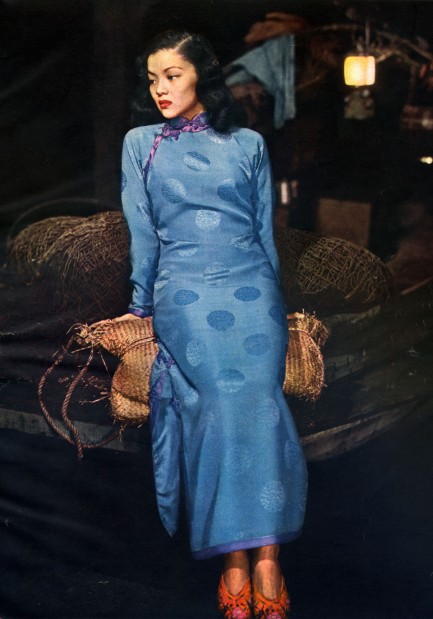
This striking image, which appeared in Esquire magazine in April 1948, shows Maylia, an actress who played Eastern beauties onscreen but was born in Detroit, Michigan as Gloria Chin. Paramount Studios promoted her as “the first Chinese star since Anna May Wong,” and indeed she was—Chinese-American, that is, just like Wong. But in the end Maylia appeared in only six films. In fact she was one of the only Asian actresses appearing in films at all during the the mid-century period. After two years of decent roles from 1947 to 1949, followed by uncredited bits in ’51 and ’53, she left show business to have a family.
 Federal authorities decide to go for broker. 
And speaking of dismemberment, a trial has commenced in Detroit involving a body broker that violated federal laws related to handling cadavers. What exactly is a body broker? These businesses provide corpses to medical schools, medical seminars, and the like, and the rules are pretty strict for this unusual industry. But back in 2013 the FBI raided International Biological, Inc.'s warehouse because of complaints about the company peddling bodies and body parts infected with HIV, sepsis, and hepatitis. During the raid authorities found frozen clumps of heads, arms, legs, organs, and torsos, as well as masses of dead insects, and eventually were forced to separate the body parts with a pneumatic chisel. Some pieces were found in ordinary beer coolers, Tupperware, paint cans, 50-gallon drums, and even in a refrigerator next to ingredients for sandwiches.
Adding a domestic twist to this mess is the fact that the government's star witness, Elizabeth Rathburn, is the ex-wife of International Biological's owner Arthur Rathburn, just below, and we presume she's telling the jury Arthur was never good at cleaning up after himself—he never put the toilet  seat down, he didn't wash dishes, and rarely if ever took out the garbage. And there's not much Arthur can say in his own defense. In fact, we bet his attorney won't even let him take the stand. seat down, he didn't wash dishes, and rarely if ever took out the garbage. And there's not much Arthur can say in his own defense. In fact, we bet his attorney won't even let him take the stand. But if he does his ex-wife should perform the cross-examination. “So, sweetie, in addition to these being almost uncategorizably heinous crimes against people who in good faith donated their bodies to science, did I not fucking tell you to get off your ass and clean up that shithole?” And when Arthur denies that he's an untidy guy she can simply say, “Your honor, as proof Arthur has no idea when to get rid of garbage the prosecution would like to enter into evidence his mustache.” We have a feeling this trial is going to end very badly for him.
 The film stars a Barker—and that's also a good description of this dog. 
This poster, which you will see when you scroll down is two sided, folded into four panels, was made for Battles of Chief Pontiac, a film starring Lex Barker in a story of war between the French and British over what is now the vicinity of Detroit, Michigan. Within this larger fight, Ottawa tribes mount a resistance against the occupying British and their German, or Hessian, mercenaries. This resistance is seriously hampered after the Ottawa are suckered into a peace parlay, then deliberately given blankets infected with smallpox. Treachery much, paleface? Why, yes, all the time.
Throughout all the battles and betrayals hero Lex Barker—the only noble white character—speaks in a neutral American accent that didn't exist 200 years ago, while the supporting white players do their best evil nazi and pompous Brit dialects. This is a nice little trick, portraying all the bad guys as essentially foreign. Never mind that the U.S. is made up of descendents of those colonists, and Barker's character is a colonist too. In cinematic terms it's a deft, almost subliminal job of blame shifting. That the film also showed overseas, where accents would have been lost on audiences, thus making it play more like a broad indictment of colonial expansionism, is an irony. Until we shared today's poster there was never any indication anywhere online that Battles of Chief Pontiac played in Japan, but the evidence is clear in this butterscotch promo—which is far more artistic than the film. Yes, this Barker vehicle is a total dog. Avoid it, except for its comedy potential—that is, if watching pasty white guys in brown shoe polish is funny. Battles of Chief Pontiac premiered in the U.S. today in 1952, and according to the poster, hit Japan in 1956. You see the right half of the front side, and the entire rear just below.
 Just being able to survive feels like success. 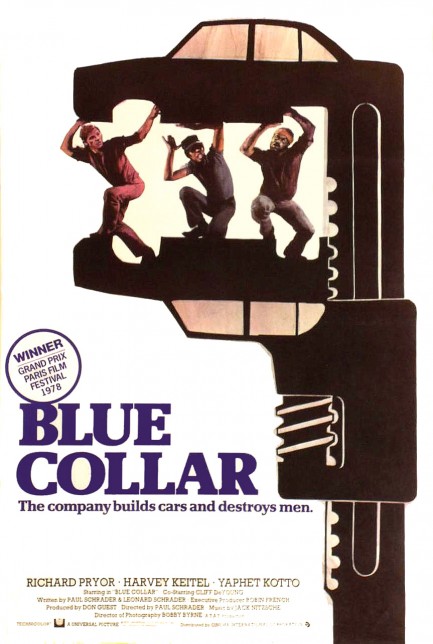
Tonight the Noir City Film Festival is screening the urban drama Blue Collar, possibly the best film on the ten-day slate. Richard Pryor, Harvey Keitel, and the underrated but indispensable Yaphet Kotto star, but this is Pryor's show, his star turn. A trio of Detroit auto workers are driven by financial desperation to rob their own union hall. They end up netting three-hundred dollars. Trouble is the union, seeking insurance money, claims it was twenty thousand. The organized crime guy who backed the job isn't interested in stories about a three hundred dollar take—he's owed ten percent and that's two grand. But there's hope—the robbery also netted a notebook filled with information on illegal loans, and if Pryor and company can sell it maybe they can come out on top after all. But just how likely do you suppose that is?
 Blue Collar is a brilliant work of art. Cinematic maverick Paul Schrader directed it, operating in a gritty milieu that would become his trademark. But the pressurized lives of the working class heroes are truly brought to life by the cast. Keitel studied under Stella Adler and Lee Strasberg, as well as at the HB Studio, while Kotto is a guy who studied at the Actors Mobile Theater Studio and made his professional acting debut in Othello, but Pryor the stand-up comic outacted them both, using self-contained fury, razor sharp humor, and just the right amount of improvisation. The man was a once-in-lifetime talent. His comedy was fused with desperation and pain, but Hollywood tried to harness the funny Pryor and jettison the rest. It was like removing his heart. He truly shone only in serious films, where he would break high tension with moments of humanizing comedy. Blue Collar was the best of the lot. Blue Collar is a brilliant work of art. Cinematic maverick Paul Schrader directed it, operating in a gritty milieu that would become his trademark. But the pressurized lives of the working class heroes are truly brought to life by the cast. Keitel studied under Stella Adler and Lee Strasberg, as well as at the HB Studio, while Kotto is a guy who studied at the Actors Mobile Theater Studio and made his professional acting debut in Othello, but Pryor the stand-up comic outacted them both, using self-contained fury, razor sharp humor, and just the right amount of improvisation. The man was a once-in-lifetime talent. His comedy was fused with desperation and pain, but Hollywood tried to harness the funny Pryor and jettison the rest. It was like removing his heart. He truly shone only in serious films, where he would break high tension with moments of humanizing comedy. Blue Collar was the best of the lot.
By today's movie standards a couple of thousand dollars hardly seems like much to fret over. Audiences are used to crime films dealing with millions. But the small amounts here make the movie feel real. A 2016 study showed that half of adult Americans would not be able to come up with $400 in an emergency—they would have to sell something, borrow money, or not pay. Back in 1978, when Blue Collar was 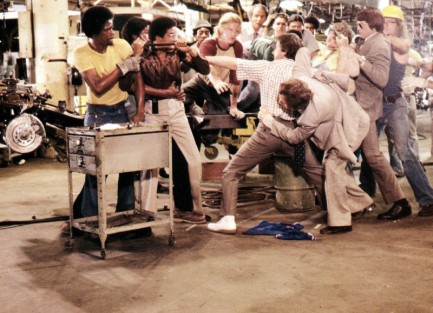 made, real wages in the U.S. were higher than they are now, so the movie depicts travails among working class people who were better off than working class people are today. Let that sink in. We think this is a perfect movie to show in San Francisco in 2017, a city overrun by tech workers contentedly pushing longtime residents out. The movie won't change anything in the city. But it will be remembered by the ticketholders at the screening. made, real wages in the U.S. were higher than they are now, so the movie depicts travails among working class people who were better off than working class people are today. Let that sink in. We think this is a perfect movie to show in San Francisco in 2017, a city overrun by tech workers contentedly pushing longtime residents out. The movie won't change anything in the city. But it will be remembered by the ticketholders at the screening.
 American literary giant Elmore Leonard dies. 
After suffering a stroke a few weeks ago, American author Elmore Leonard died at his home in Detroit this morning. Tens of thousands of words will be written about Leonard’s contributions to literature, but we’ll let him speak for himself in this scene featuring a character named Neely Tucker, a journalist intent on perfectly remembering everything that happens, as he witnesses a brewing confrontation between a Cuban military officer and a tough cowboy in a supper club in Havana, Cuba, 1899: It surprised Neely that Teo didn’t acknowledge Amelia first, ask her pardon for interrupting, walking up to the table unannounced. Amelia’s eyes were glued to the two men facing each other, Teo saying now in a very formal manner, “I request that you meet me tomorrow…” with an accent but the words clear enough: that Tyler meet him in the morning at first light in the Prado by the statue of Her Majesty Queen Isabella, Teo saying his second, Major Lionel Tavalera, would bring the pistols and Tyler would be given his choice of which one he would prefer to use. Look at Amelia’s eyes, big as saucers, the sweet thing hanging on every word. Tyler said, “I thought you wanted to sword fight.” She loved it, looking at Tyler almost adoringly. Tyler saying, “Now you want to shoot me. ’Cause I wouldn’t saddle a horse for you?” Neely would tell her later her mouth was open and it distracted him, made it hard for him to concentrate on the details, and he didn’t want to take out his notebook—how would that look? He’d have to remember what was said. Teo was saying now, “You insult me.” Tyler asking him, “How do I do that?” “The way you speak. You show no respect.” “Why should I respect you?” “There. You see?” “What you need to do,” Tyler said, “is get over your touchiness. You understand what I mean? You’re too sensitive, got a thin skin on you. I’m not gonna stand out there by a statue and let you aim your pistol at me, not over something as piddling as you wanting your own way.” There was no mistaking the hussar officer’s expression of hostility. Neely noted the narrowing of his eyes to slits; he glanced at Amelia to see the adorable creature completely absorbed. Spellbound. Tyler saying now to Teo, “You have a war going on. Doesn’t it give you enough people to kill?” Teo didn’t waste a moment. Neely watched him shift his gloves from his left to his right hand and crack Tyler across the face, stinging him good with those kid gloves—harder in fact than need be, only the formality of the slap required and ordinarily accepted as a challenge. What was in no way part of the duello rites was Tyler cocking his fist and driving it hard into Teo’s wide-eyed expression, sending him stumbling back off-balance all the way to the bar, where Lionel Tavalera caught him around the shoulders and kept him on his feet. Neely could see that Teo, now the center of attention, wanted no help from anyone. He used his elbows to free himself of Tavalera, and Neely thought, Now what? Rant and rave? Promise the American he’ll kill him for sure on the morrow? No, what Teo did, he drew a short-barrel pistol from inside his suit—a .32, it looked like—extended the weapon in what must be a classic dueling pose in the direction of Tyler, barely more than six paces away, and while he was taking deliberate aim, intent on an immediate finish to this business, Tyler pulled a big .44 revolver from inside his new alpaca coat and shot Teo Barbón in the middle of the forehead. My Lord, the sound it made! And there, you could see the bullet hole like a small black spot, just for a moment before Teo fell to the floor. That’s how magical writing can be, how masterly. Leonard shifts from past tense, to simple present tense, to progressive present, to future, and even mixes in conditional mood effortlessly, as he shuffles Neely Tucker’s in-the-moment observations of the incident with his concerns about how he’ll write it up for his newspaper and his internal dialogue concerning the beautiful onlooker Amelia Brown. All in that passage. That’s how good he was. And the rhythm of his long, multi-clause sentences—because writing is crucially rhythmic—is mesmerizing, aided by his careful use of punctuation. Those lines are from his best book, in our opinion, Cuba Libre, which is not one of his standard American westerns nor one of his many hard-boiled crime books, but rather an adventure set in Cuba on the eve of the Spanish American War, and it’s one of the books people will remember, and probably study in college courses. Yes, Leonard breaks some of the unspoken rules of elegant writing, yet rules are often successfully broken by great artists—indeed, it’s almost a pre-requisite.
A couple of years ago, a long article appeared in The Guardian and their book critic pointed out that Leonard was not a great a crime novelist or a great western novelist, but simply a great novelist, one of the best writing in English and had been for at least twenty years. He said a shift had begun to occur in literary circles and critics were beginning to realize nobody else in any genre or branch of literature could do what Elmore Leonard did. Dead today at age eighty-seven.
 Thirty-eight years later the FBI still can’t get him Hoffa their list of troublesome unsolved cases. One of the most famous missing persons in American history is back in the news. The FBI is searching a field in suburban Detroit where they've been informed long missing and presumably murdered Teamsters labor union president Jimmy Hoffa was buried. Hoffa disappeared in July 1975 from the parking lot of a Detroit restaurant and was never seen again. The new search is occurring because an ex-Mafia underboss named Tony Zerilli told the Detroit TV station WDIV in February that he knew where Hoffa was buried. Zerilli says Hoffa was bound, gagged, smacked on the head with a shovel and buried alive. Why did he come forward now? You guessed it—he’s promoting a book. Did he actually see Hoffa get the brutal treatment he descibes? No, he was told about it—if he’d been there personally that would constitute a crime, right? Will Hoffa actually turn up? Hard to say. The FBI is making noises that Zerilli is a credible source, but we think two other factors are just as important in triggering this search—Hoffa’s place in American cold case lore is a longtime thorn in the FBI’s side, and, probably of more importance, the Hoffa family remains prominent even today, with one of his sons serving as the current Teamsters president and one of his daughters a former circuit judge. Zerilli says he was told Hoffa was buried beneath a concrete slab inside a barn. The barn has since been razed but the FBI are bringing in heavy equipment to dig up the area. Zerilli’s report is believable in at least one sense—Hoffa has been reported to be buried everywhere from the Florida Everglades to the New Jersey Meadowlands, but the field where the FBI is searching is just a short distance from where he was last seen alive.

|
 |

The headlines that mattered yesteryear.
1986—Otto Preminger Dies
Austro–Hungarian film director Otto Preminger, who directed such eternal classics as Laura, Anatomy of a Murder, Carmen Jones, The Man with the Golden Arm, and Stalag 17, and for his efforts earned a star on Hollywood's Walk of Fame, dies in New York City, aged 80, from cancer and Alzheimer's disease. 1998—James Earl Ray Dies
The convicted assassin of American civil rights leader Martin Luther King, Jr., petty criminal James Earl Ray, dies in prison of hepatitis aged 70, protesting his innocence as he had for decades. Members of the King family who supported Ray's fight to clear his name believed the U.S. Government had been involved in Dr. King's killing, but with Ray's death such questions became moot. 1912—Pravda Is Founded
The newspaper Pravda, or Truth, known as the voice of the Communist Party of the Soviet Union, begins publication in Saint Petersburg. It is one of the country's leading newspapers until 1991, when it is closed down by decree of then-President Boris Yeltsin. A number of other Pravdas appear afterward, including an internet site and a tabloid. 1983—Hitler's Diaries Found
The German magazine Der Stern claims that Adolf Hitler's diaries had been found in wreckage in East Germany. The magazine had paid 10 million German marks for the sixty small books, plus a volume about Rudolf Hess's flight to the United Kingdom, covering the period from 1932 to 1945. But the diaries are subsequently revealed to be fakes written by Konrad Kujau, a notorious Stuttgart forger. Both he and Stern journalist Gerd Heidemann go to trial in 1985 and are each sentenced to 42 months in prison. 1918—The Red Baron Is Shot Down
German WWI fighter ace Manfred von Richthofen, better known as The Red Baron, sustains a fatal wound while flying over Vaux sur Somme in France. Von Richthofen, shot through the heart, manages a hasty emergency landing before dying in the cockpit of his plane. His last word, according to one witness, is "Kaputt." The Red Baron was the most successful flying ace during the war, having shot down at least 80 enemy airplanes. 1964—Satellite Spreads Radioactivity
An American-made Transit satellite, which had been designed to track submarines, fails to reach orbit after launch and disperses its highly radioactive two pound plutonium power source over a wide area as it breaks up re-entering the atmosphere.
|

|
|

It's easy. We have an uploader that makes it a snap. Use it to submit your art, text, header, and subhead. Your post can be funny, serious, or anything in between, as long as it's vintage pulp. You'll get a byline and experience the fleeting pride of free authorship. We'll edit your post for typos, but the rest is up to you. Click here to give us your best shot.

|
|



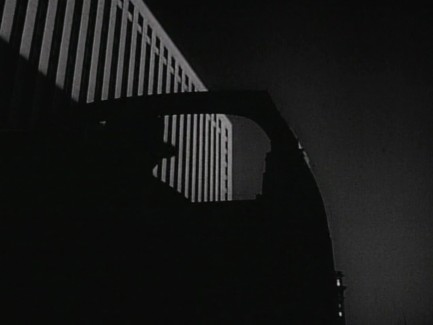
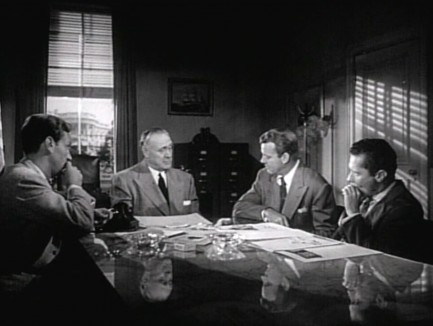
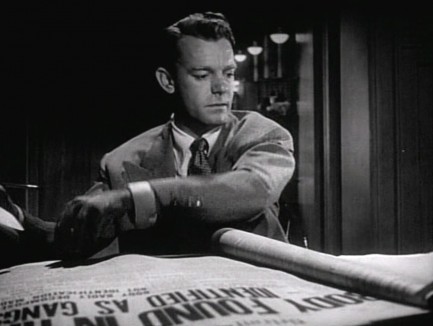
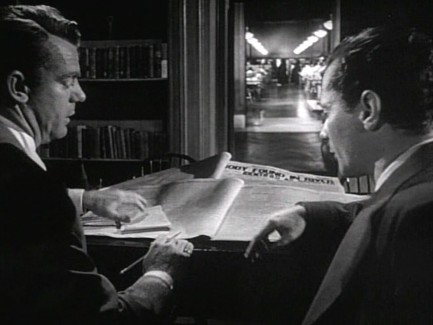
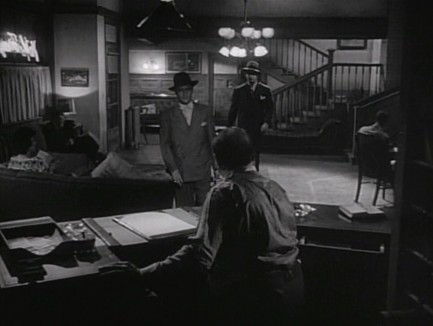
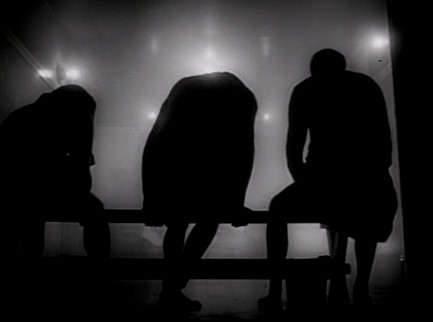
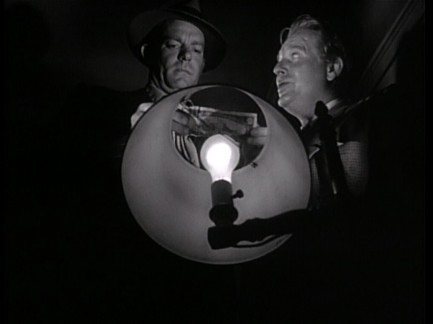
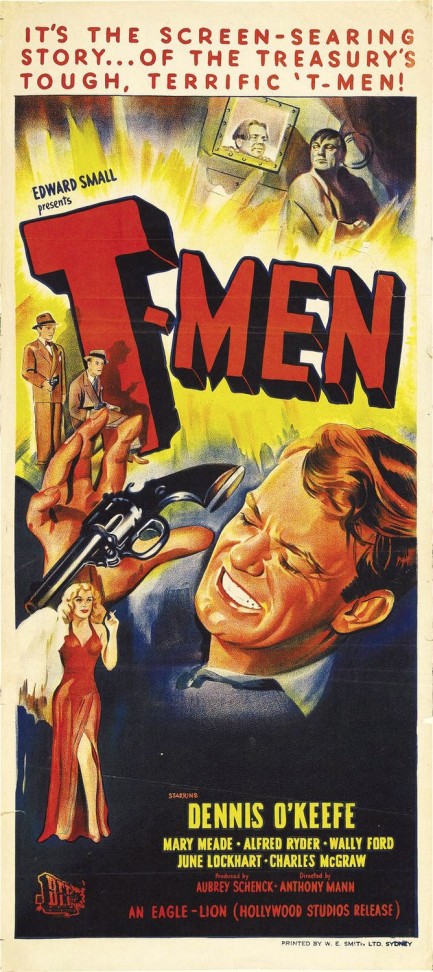


























 we've reached this point should read up on private prisons, or Citizen's United v. FEC, or Facebook's recent attempt to punish the entire country of Australia by slapping it with a news ban.
we've reached this point should read up on private prisons, or Citizen's United v. FEC, or Facebook's recent attempt to punish the entire country of Australia by slapping it with a news ban.




 seat down, he didn't wash dishes, and rarely if ever took out the garbage. And there's not much Arthur can say in his own defense. In fact, we bet his attorney won't even let him take the stand.
seat down, he didn't wash dishes, and rarely if ever took out the garbage. And there's not much Arthur can say in his own defense. In fact, we bet his attorney won't even let him take the stand.

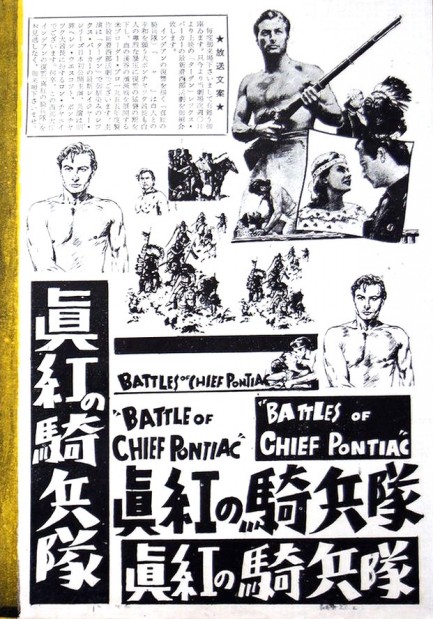
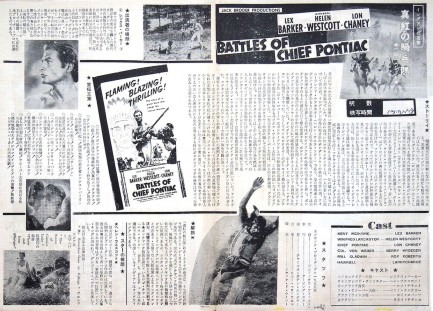


 Blue Collar is a brilliant work of art. Cinematic maverick Paul Schrader directed it, operating in a gritty milieu that would become his trademark. But the pressurized lives of the working class heroes are truly brought to life by the cast. Keitel studied under Stella Adler and Lee Strasberg, as well as at the HB Studio, while Kotto is a guy who studied at the Actors Mobile Theater Studio and made his professional acting debut in Othello, but Pryor the stand-up comic outacted them both, using self-contained fury, razor sharp humor, and just the right amount of improvisation. The man was a once-in-lifetime talent. His comedy was fused with desperation and pain, but Hollywood tried to harness the funny Pryor and jettison the rest. It was like removing his heart. He truly shone only in serious films, where he would break high tension with moments of humanizing comedy. Blue Collar was the best of the lot.
Blue Collar is a brilliant work of art. Cinematic maverick Paul Schrader directed it, operating in a gritty milieu that would become his trademark. But the pressurized lives of the working class heroes are truly brought to life by the cast. Keitel studied under Stella Adler and Lee Strasberg, as well as at the HB Studio, while Kotto is a guy who studied at the Actors Mobile Theater Studio and made his professional acting debut in Othello, but Pryor the stand-up comic outacted them both, using self-contained fury, razor sharp humor, and just the right amount of improvisation. The man was a once-in-lifetime talent. His comedy was fused with desperation and pain, but Hollywood tried to harness the funny Pryor and jettison the rest. It was like removing his heart. He truly shone only in serious films, where he would break high tension with moments of humanizing comedy. Blue Collar was the best of the lot.
 made, real wages in the U.S. were higher than they are now, so the movie depicts travails among working class people who were better off than working class people are today. Let that sink in. We think this is a perfect movie to show in San Francisco in 2017, a city overrun by tech workers contentedly pushing longtime residents out. The movie won't change anything in the city. But it will be remembered by the ticketholders at the screening.
made, real wages in the U.S. were higher than they are now, so the movie depicts travails among working class people who were better off than working class people are today. Let that sink in. We think this is a perfect movie to show in San Francisco in 2017, a city overrun by tech workers contentedly pushing longtime residents out. The movie won't change anything in the city. But it will be remembered by the ticketholders at the screening.


